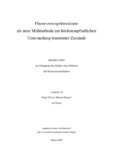Citation link:
https://nbn-resolving.org/urn:nbn:de:hbz:467-1511Files in This Item:
| File | Description | Size | Format | |
|---|---|---|---|---|
| heupel.pdf | 2.6 MB | Adobe PDF |  View/Open |
| Dokument Type: | Doctoral Thesis | metadata.dc.title: | Fluoreszenzspektroskopie als neue Meßmethode zur höchstempfindlichen Untersuchungen transienter Zustände | Authors: | Heupel, Martin | Institute: | Fachbereich 8, Chemie - Biologie | Free keywords: | Transientenspektrometer, Lock-In-Technologie, Fluoreszenzspektroskopie | Dewey Decimal Classification: | 540 Chemie | GHBS-Clases: | UVQ | Issue Date: | 2000 | Publish Date: | 2006 | Abstract: | Ziel der vorliegenden Arbeit war es einerseits, durch die Etablierung der sogenannten Rotationsküvetten-Technik den Anwendungsbereich eines bestehenden Transientenspektrometers erheblich zu erweitern. Das zugrunde liegende Meßsystem zeigte dabei Nachteile auf. Diese sollten durch die Entwicklung eines neuen Meßprinzips aufgehoben werden, um Untersuchungen an Fluoreszenzfarbstoffen durchführen zu können, die in aktuellen Forschungsrichtungen ihren Einsatz finden. Im ersten Teil der Arbeit wurde die Weiterentwicklung eines Transientenspektrometers vorgestellt, mit Hilfe dessen durch Absorptionsmessungen die Triplett-Lebensdauer und die Intersystem-Crossing Ratenkonstante von organischen Farbstoffen bestimmt werden können. Im zweiten Teil wurden neuartige Untersuchungen transienter Zustände an unterschiedlichen Fluoreszenzfarbstoffen vorgestellt, die durch das weiterentwickelte Transientenspektrometer ermöglicht wurden. Im dritten Teil wurde die Idee der Fluoreszenzreduktion aufgegriffen und ein neues Meßprinzip vorgestellt, das auf der Messung der Fluoreszenz beruht. Durch die Anwendung dieses neuen Meßprinzips konnten Messungen durchgeführt werden, die mit dem bestehenden Transientenspektrometer, das auf der Messung der Absorption beruht, nicht möglich waren. Die Ergebnisse dieser Untersuchungen an Fluoreszenzfarbstoffen aus aktuellen Forschungsgebieten wurden im vierten Teil der Arbeit vorgestellt. Durch die Kombination der Absorptions- und der Fluoreszenzreduktions-Meßmethode in Verbindung mit der neu entwickelten Rotationsküvetten-Technik steht nun eine Meßapparatur zur Verfügung, die einen erheblich erweiterten Anwendungsbereich ermöglicht. The aim oft the present work was to extend the range of application of the existing transient spectrometer by establishing the so called rotational-cuvette-technique. Thereby the basic measurement system had disadvantages. Those disadvantages should be removed by the development of a new principle of measurement to carry out measurements on fluorescent dyes applied in actual scientific investigations. In the first part of the work the development of the transient spectrometer is shown, giving the possibility to detect the triplet lifetime an the intersystem crossing rate constant of organic dyes by absorption measurements. In the second part new investigations of transient states of various fluorescent dyes are presented, enabled by the further development of the transient spectrometer. In the third part the idea of fluorescent reduction has been picked up and a new principle of measurement has been introduced, based on the detection of fluorescence. By the application of this new principle it was possible to carry out measurements, which were not possible by using the spectrometer based on the measurement of absorption. The results of these investigations on fluorescent dyes applied in actual scientific research are shown in the fourth part of the present work. The combination of the absorption- and the fluorescence-based measurement system in combination with the new rotational-cuvette-system offers a measurement equipment with a widely enlarged range of application. |
URN: | urn:nbn:de:hbz:467-1511 | URI: | https://dspace.ub.uni-siegen.de/handle/ubsi/151 | License: | https://dspace.ub.uni-siegen.de/static/license.txt |
| Appears in Collections: | Hochschulschriften |
This item is protected by original copyright |
Page view(s)
310
checked on Nov 25, 2024
Download(s)
174
checked on Nov 25, 2024
Google ScholarTM
Check
Items in DSpace are protected by copyright, with all rights reserved, unless otherwise indicated.

